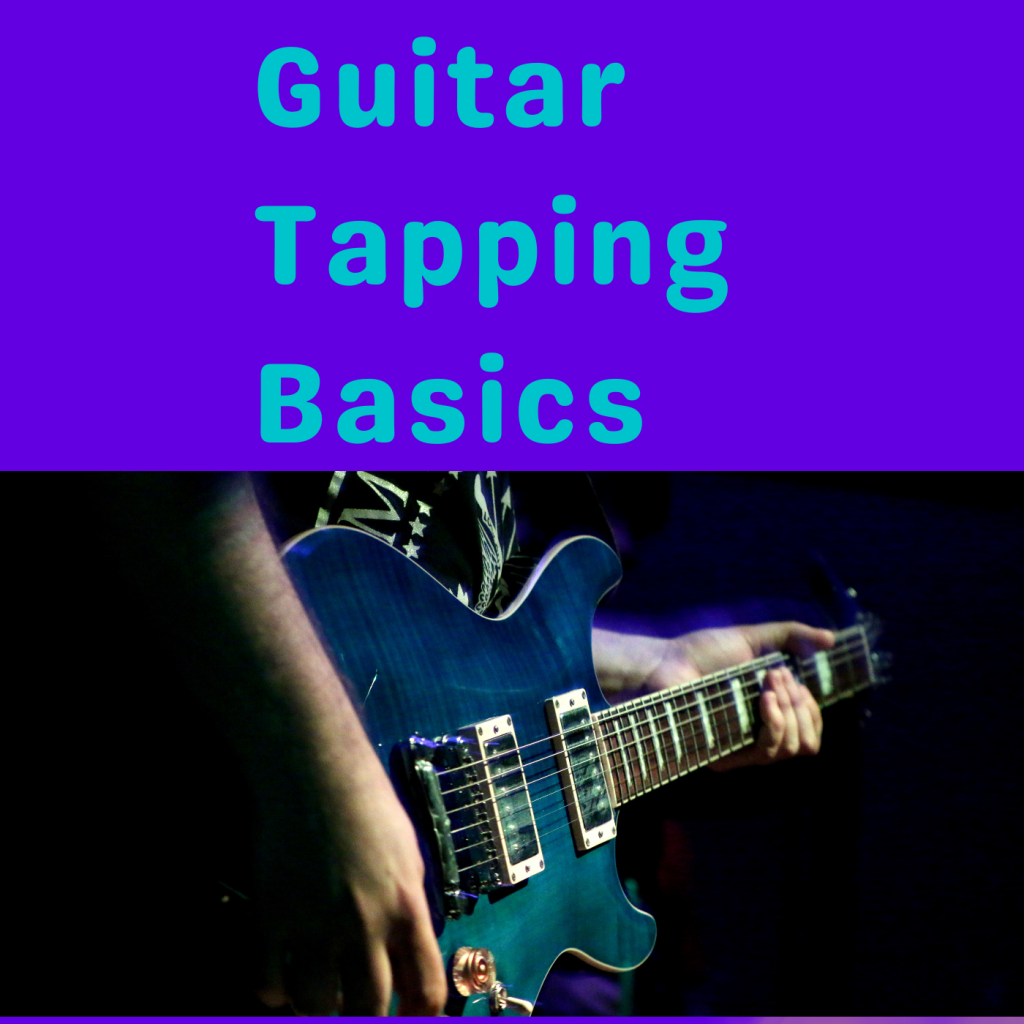Introduction to Guitar Exercises
Improve your guitar playing skills with these 20 best guitar exercises to make you a better guitarist.
You’ll learn warm-up exercises, finger dexterity exercises, chord progression exercises, scale exercises, arpeggio exercises, picking exercises, sweep picking exercises, broad technique guitar exercises, and more!
Whether you’re a beginner or a pro, there’s a guitar exercise in here for you.
Table of Contents
Warm-ups Guitar Exercises
Guitar exercises 1. Stretching
As a guitarist, you always need to take care of your wrists and fingers. Not doing so could result in lackluster technique for either hand, or long-term health issues!
I constantly do stretches, which in-turn allows me to maximize my technical performance, and minimize soreness in both of my hands.
Seymour Duncan put together this awesome post to help you out with your stretching. I use a lot of these exercises myself!
Keep it Loose: Stretches for Guitarists
Guitar exercises 2: Spider exercises
Spider exercises, sometimes called spider-walking or finger twisting, are some of the most common warm-up guitar exercises.
They use all 4 fingers on the fretting hand, plus they put your right hand to work as well. This means spider exercises are a surefire way to sync up your left and right hand and build speed.
You can concoct spider exercises by assigning fingers 1-4 to fret numbers in their respective position on the fretboard.
For example, in position 1 you’d place your fingers on these frets:
- Fret 1 = 1st finger (index)
- Fret 2 = 2nd finger (middle)
- Fret 3 = 3rd finger (ring)
- Fret 4 = 4th finger (pinky)
This is the most common version of the spider exercise warm-up.
Alternate pick the entire exercise. It simply ascends, then descends using the same notes.
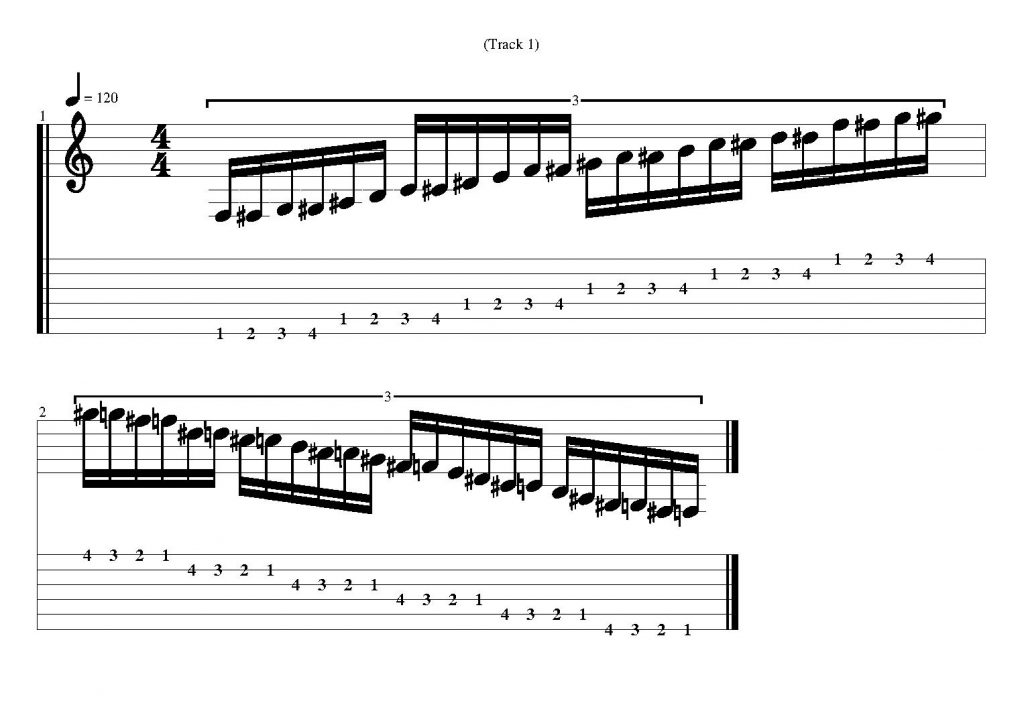
Guitar exercises 3: Fretboard note name memorization
Memorizing your fretboard is a must for any guitarist wanting to make the leap from guitar player to musician.
Here’s a complete lesson on memorizing the fretboard.
Start by learning the natural note names on the E string. Once you have this down you’ll have 1/3rd of the fretboard memorized!
You only need to memorize the natural notes, because you know where the sharps and flats are if you know where the natural notes are.
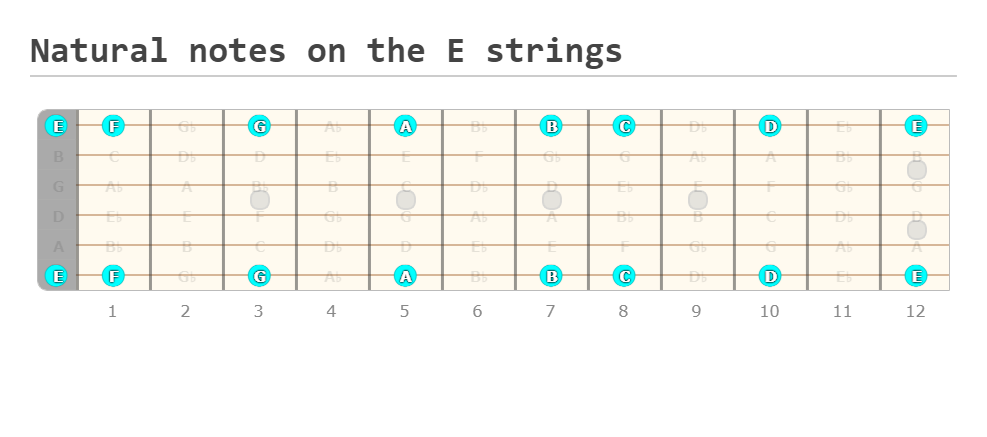
From there, pick a single note, let’s say the E note, and find it at every position on the fretboard. You’ll quickly start to see and understand how far apart notes are, and how notes overlap.
You can easily find these notes if you understand how octaves work.
In the beginning, only practice this exercise with natural notes.
Technique and Lead Guitar Exercises
Guitar exercises 4. Alternate picking scales
Alternate picking is an essential technique for any guitarist looking to improve their picking attack, speed, and accuracy.
Here’s one of my favorite alternate picking exercises, derived from the A minor pentatonic scale!
You can apply this alternate picking sequence to any shape of the minor pentatonic scale.
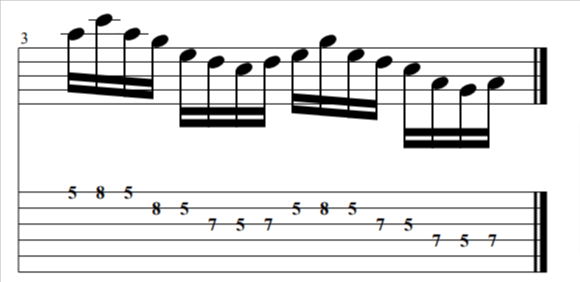
Guitar exercises 5. Hammer-ons
Hammer-ons give you that epic legato sound that every guitar player and music nerd alike loves so much.
This is an intermediate hammer-on exercise using the A minor pentatonic scale.
Here’s how to play each group of 8 notes:
- First 2 notes: Pick, then hammer-on
- Second 2 notes: Use 2 upstrokes
- Third 2 notes: Pick, then hammer-on
- Fourth 2 notes: Pick, then hammer-on
This gives you a total of 8 notes. This exercises has 16 total notes, which gives you 2 groups of 8 notes, and this picking pattern remains the same for each 8-note grouping.
You can use this picking pattern for any 2-notes-per-string shape.

Guitar exercises 6. Hammer-ons and Pull-offs
Pull-offs can be a little tricky, and they’re usually combined with hammer-ons.
Remember, when pulling off you’ll use your fret hand to pull-off the string with a downward force, essentially plucking the string, and pulling off to a note that’s already fretted.
This is one of my favorite guitar exercises because it’s so simple and so rockin’!
Try it in other pentatonic positions as well.

Guitar exercises 7. String skipping
This string skipping lick is played using the A minor pentatonic scale, and also gives you a chance to exercise your hammer-ons!
Just pick each string with a downstroke, then hammer-on to the 2nd note for each string.
Alternatively, you could hybrid pick every other string using your middle finger. This means you’d pick the first set of 2 notes with your plectrum, then the next 2 notes with your middle finger.

Guitar exercises 8. Whole-step bends
This is a tasty blues and rock guitar lick that uses whole-step bends.
Practice whole step bends by playing the note you’re trying to bend to, then play the bend, and make sure it matches the pitch of that note. You can do this exercise with half-step bends, too!
In this exercise, you’re bending to the E note on the G string, which is at the 9th fret. Play the 9th fret of the G, then practice the bend.
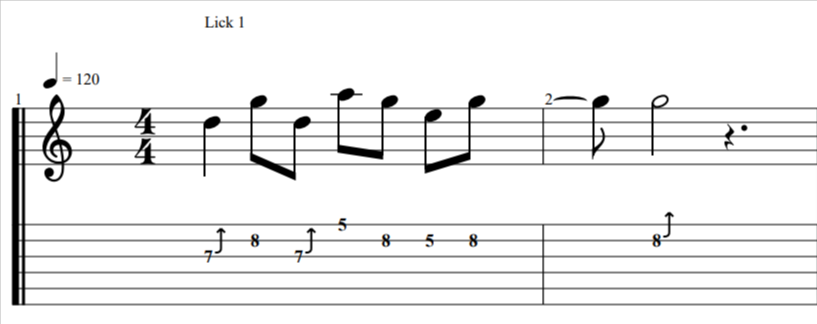
Guitar exercises 9. Basic sweep picking exercise
This is a basic sweep picking exercise that moves from G major to E minor.
As a side note, you can turn a lot of your guitar exercises into sweep picking/ economy picking exercises if you understand the techniques. Remember, sweeping can be used for a lot more than arpeggios!
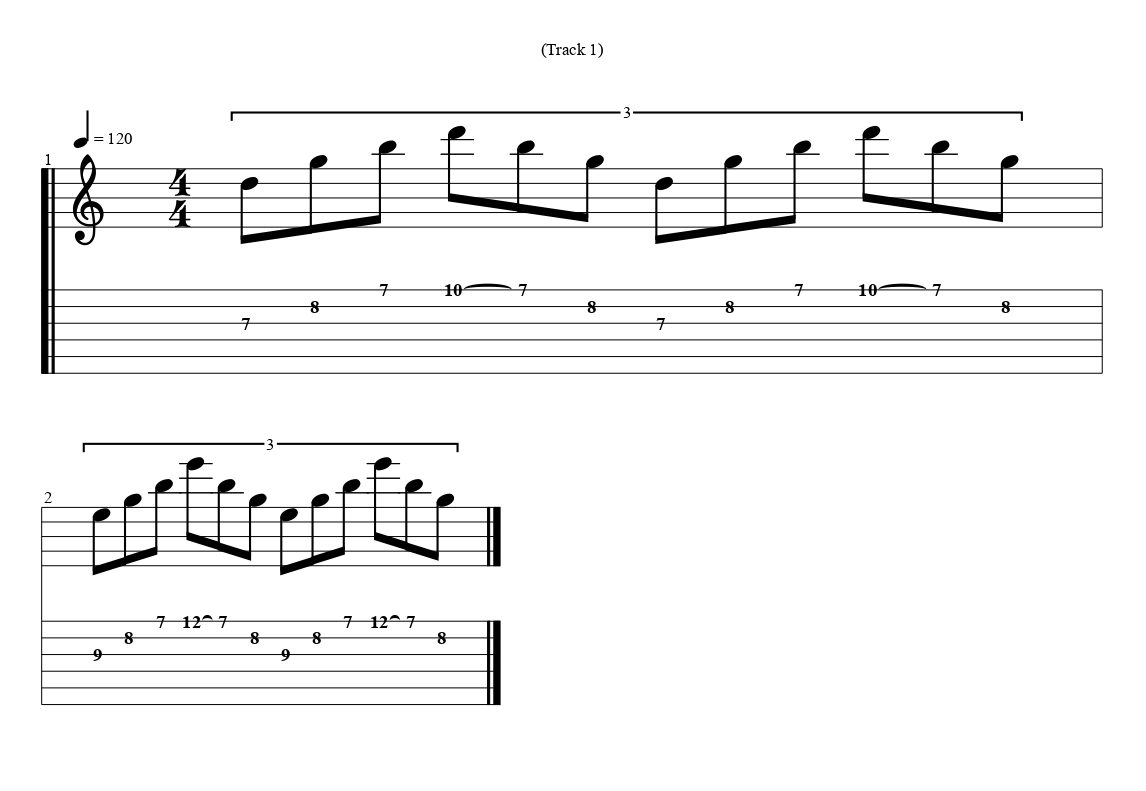
Arpeggio Exercises
These are my favorite arpeggio guitar exercises.
If you don’t know, an arpeggio is just a broken down chord played out of harmony, meaning one note at a time.
Check out this lesson if you want an in-depth arpeggios explanation.
Guitar exercises 10. Major arpeggios
This major arpeggio is so cool, because it’s so simple, and you only need to know one 3-note, 3-finger shape to apply it.
Because of it’s simple, yet epic nature, it’s perfect for beginners and pros alike.
Here’s the fret-hand fingering:
- Middle finger on G, the root
- Index finger on B, the major 3rd
- Pinky finger on D, the perfect 5th
This finger pattern stays consistent as you move from one octave to the next!
Try transposing (changing the root note) this arpeggio shape/ exercise. It will be a great addition to your improvisational repertoire.
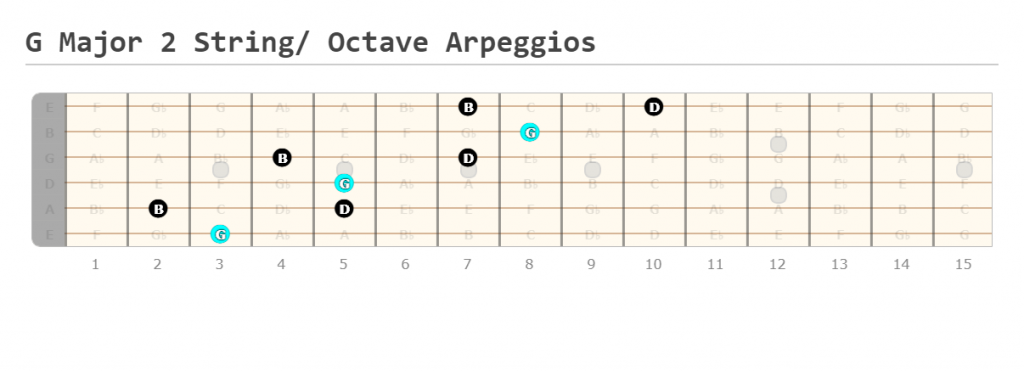
Guitar exercises 11. Minor arpeggios
Here are 2 simple minor arpeggios exercises.
This first exercise is an E minor arpeggio that uses a D minor shape. I suggest sweeping it.
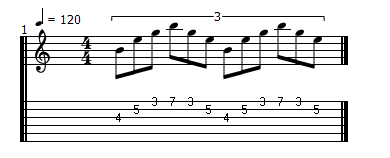
This 2nd minor arpeggio is an A minor arpeggio. This one requires tapping!
I suggest trying this shape at the same position on each string. Moving up, from high E to Low E, this would give you the minor arpeggios:
- A minor
- E minor
- C minor
- G minor
- D minor
- A minor
Try it out! You’ll sound like Eddie Van Halen in no time.
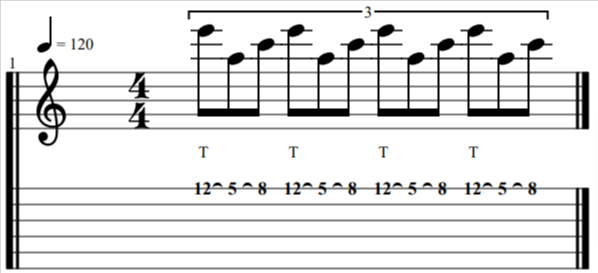
Guitar exercises 12. Tapping arpeggios
This example uses these 4 arpeggios in order:
Diminished-minor-major-augmented
This will expand your single-string arpeggio knowledge by giving you 4 different triad shapes to work with.
Remember to practice them with different root notes!
Don’t know how to tap? Check out my tapping lesson.
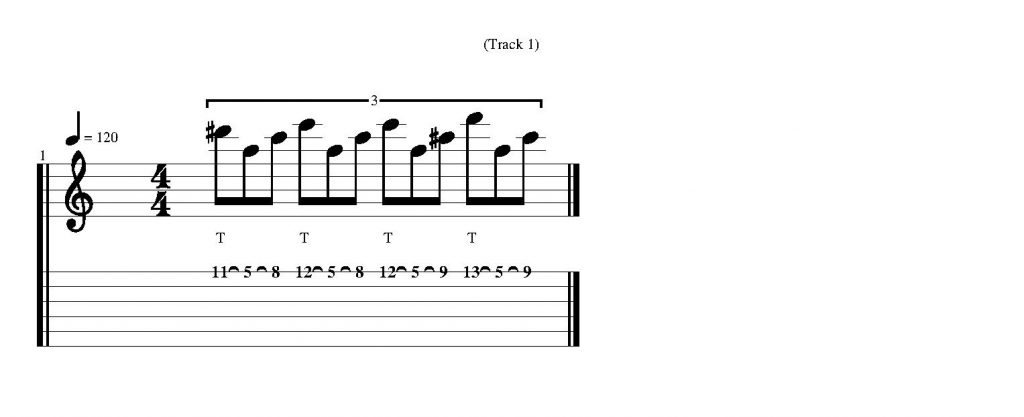
Guitar exercises 13. Descending diminished arpeggios in minor 3rds
This exercise uses the same diminished shape as you move up in minor thirds.
Minor third intervals = 3 frets
With the fretting hand starting from the high E string, descend this shape using your ring, index, and middle fingers.
As for the picking hand, you can descend with sweep picking, alternate picking, or even fingerstyle!

Chord and Rhythm Guitar Exercises
Guitar exercises 14. 4-Step fretting exercise
This is an exercise for memorizing chords that I learned from an old guitar book.
It’s simple, and it follows 4 steps:
- Set
- Press
- Set
- Release
To get used to the exercise, practice this with a chord you’re familiar with. Once you have it down, use it to memorize new chord shapes.
Here’s a deeper explanation for each step.
1: Set– Create your chord shape, and set it on the strings lightly.
2: Press– Play the chord
3: Set– Put your fingers back in the set position, roughly 1/8th of an inch away from the fretboard.
4: Release– Let go of the chord
I like this exercise because it takes the stress out of practicing and memorizing chord shapes.
You can find a video addressing this exercise in module 3B of my guitar course. Using that link you can get 1 month free on Skillshare, which you can use to watch the course!
Guitar exercises 15. 1-4-5 Chord Progression
The 1-4-5 is arguably the most common chord progression in all of Western music.
Practice 1-4-5 progressions by finding the root note and identifying where the 4th and 5th intervals are located relative to the root note. The chart below will help you with this process.
From there, you can use your CAGED shapes to create 1-4-5 chord progressions in both major and minor keys.
Here’s my complete lesson on the 1-4-5 chord progression for guitar.
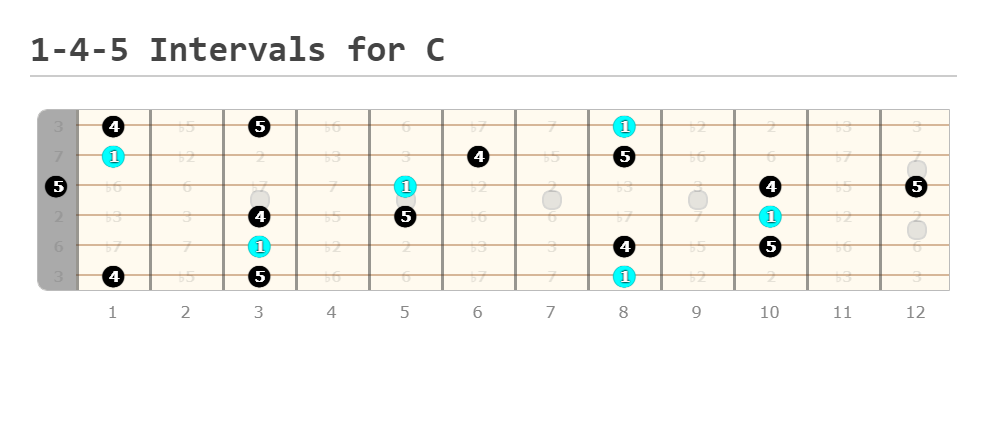
Guitar exercises 16. Remembering 7th chords
This exercise will help you expand your chord vocabulary fast, and give you a better understanding of intervals and chord structures.
Start with the Cmaj7 shape, then continue to change chords, moving to C7, Cmin7, Cmin7b5, Cdim7, and ending on Cmin11.
This will give you 6 jazz chord shapes with the same root note! Pay attention to the intervals that change as you move from one chord to the next.
Here’s a complete lesson on jazz guitar chords.
Here’s a complete lesson on 7th chords.






Guitar exercises 17. CAGED chords exercise
Your CAGED chords, if you don’t know, are the open C, A, G, E, and D chord shapes.
Every major triad shape on the fretboard can be created using these shapes. It’s pretty cool!
One of the best CAGED guitar exercises is simply taking all 5 CAGED shapes and applying them to a single root note.
This is demonstrated below using the G major chord.





Scale guitar exercises
Guitar exercises 18: Octave scale exercise in G major
If you can’t tell, I’m a big fan of moving around in octaves. Octave shapes make it so easy to move around the entire fretboard, and they’re easy to memorize because of they’re consistent patterns for the left and right hands.
This G major scale octave exercise moves in groups of 6 notes ascending, using notes G-A-B-C-D-E in each octave.
It then descends using notes D-C-B-A-G-F# in each octave.
Resolve on the root note G if you want a smooth sounding resolution.
Here’s a complete lesson on moving scales in octaves.

Guitar exercises 19. Whole tone alternate picking
This is a simple whole tone exercise using alternate picking. You could also hammer-on to the 2nd note on each string.
You’ll use the index and ring fingers consistently, moving up in whole steps!

Other Patterns and Guitar Licks
These guitar exercises and licks are great for technique practice, scale practice, phrasing, and improvisation.
They don’t necessarily follow in to the broad exercise categories from above, so that’s why they’re considered the “other” guitar patterns and licks.
Guitar exercises 20. Hexatonic pattern
Hexatonic patterns are very popular amongst shredders in rock and metal.
Hexatonic patterns are simply diatonic groups of six notes. This particular hexatonic pattern uses diatonic sixes from the key of E minor.
I covered this idea in my metal guitar techniques lesson as well.

Conclusion and tips for effective guitar exercises
You officially have 20 of the best guitar exercises to make you a better guitarist.
Nailing guitar exercises comes through consistent practice, patience, and dedication, so just stick with them!
Focus and work on the exercises that align with your current guitar goals. From there, you can learn other exercises.
Through practicing guitar exercises regularly, you’ll expand your overall playing technique and musical vocabulary.
Rock on!


